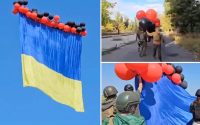First images of the Chinese spy balloon recovery efforts
The US military unveiled the first official images of its Chinese spy balloon recovery efforts Tuesday — as sailors continued to trawl the South Carolina coast for debris from the downed craft.
Navy personnel were pictured hauling large sections of the high-altitude balloon — which US officials say measured 200 feet tall — from the waters off Myrtle Beach after the surveillance device was shot down on Saturday.
In one image, which offered the closest glimpse yet of the device, half a dozen sailors could be seen dragging pieces of the balloon’s white outer fabric and sections of its metal shell structure onto a vessel.
Military officials haven’t yet determined the condition of the device — or how many pieces it may be in — and unmanned underwater vehicles are being used to scan the sea floor to retrieve all remaining parts of the balloon.
Once collected, the pieces of the obliterated craft are being taken to the FBI Laboratory at Quantico, Va., to be examined by the bureau and other counter-intelligence authorities in a bid to understand what type of sensors the Chinese were using and how the balloon was able to maneuver.



While President Biden faced some criticism for delaying his shootdown order until the balloon was over the Atlantic Ocean, White House national security adviser Jake Sullivan insisted that bringing the device down over water – instead of land — created a greater possibility of being able to “effectively exploit the wreckage.”
RAND senior technical analyst Brynn Tannehill agreed, telling The Post on Tuesday there were multiple reasons military officials would have given Biden that advice.
“Logically, if you shoot something down over land, you’re going to shoot down over somewhere that’s uninhabited. You’re going to be picking wreckage out of trees … it’s going to be scattered,” Tannehill said.
In the event that the balloon landed on something hard, like a road, Tannehill said the device might be easier to locate – “but you’ve shattered it … you’ve just dropped a camera from 60,000 feet onto pavement.”


By contrast, Tannehill went on, “the ocean floor is sandy, wet … generally pretty flat.”
In addition, Tannehill noted, the search location in the part of the ocean where the spy craft landed was only around 50 feet deep.
“The beauty of that is now you have debris over a relatively flat surface that has taken perhaps less damage if it came down over land,” she said. “When you go in with sonar scanners … it shows up very nicely.”
US officials have said the successful recovery of the balloon could provide valuable insight into China’s spying capabilities — despite the Biden administration downplaying the downed device’s impact on national security.
“We need to understand more fully the Chinese surveillance capabilities and systems,” retired Navy Adm. Harry Harris, the former US Indo-Pacific Command commander, said during a House Armed Services Committee hearing on Tuesday.
“Shooting down that [balloon] and then recovering the parts over the Atlantic, I think, is very helpful in that regard.”
Air Force Gen. Glen VanHerck, head of US North American Aerospace Defense Command and Northern Command, said Monday the Navy was taking protective measures during the recovery efforts, in case there are explosives on the balloon.
VanHerck also said the debris was spread out over an area measuring more than “15 football fields by 15 football fields square” — about three-quarters of a square mile.
With Post wires


